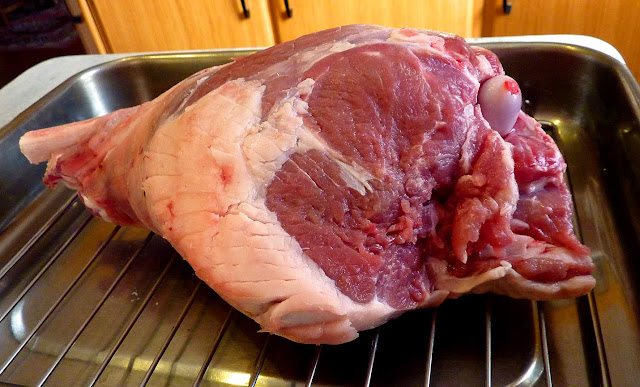This getting out of bed and finding the house all warmed up is going to take some getting used to. That's the new boiler in action — the new thermostat, actually. It's a four-by-six-inch tabletop unit that you can use to program and adjust the boiler temperature. Over the years, I had gotten used to getting up to a house at 12 to 15 degrees Celsius (55 to 60ºF) on winter mornings, going down to switch on the boiler, and waiting an hour or so for the living room to warm up enough to feel comfortable.
This morning when I got up at 5:45, the living room was already at 19.2ºC. That's pretty much the temperature we want to maintain all day — about 67ºF — until evening, when we let the place gradually cool down. To be honest, it actually feels too warm when I first get out of bed. I guess, as I said, I'll get used to it. It's also abnormally warm outdoors this morning.
Collards cooked in tomato sauce with a mix of beans and some chunks of lamb
Meanwhile, I got sidetracked this morning by a comment from an anonymous reader who wanted to know where one might be able to buy fresh collard greens in Paris. I suggested the organic market on Boulevard Raspail on Sunday mornings, the Marché d'Aligre, and the Marché Richard-Lenoir at Bastille as possibilities. It would be worth shopping around at other outdoor markets in Paris too. If you have any tips for this reader, please leave a comment.
We had collard greens for lunch yesterday. A couple of days ago, I had thawed out some collards that I'd cooked with tomatoes, chickpeas, and lardons and put in the freezer. To those, I added the leftover French flageolet beans we had eaten with lamb on Friday, some cooked black-eyed peas I found in the fridge, and some chunks of rare lamb that I sliced off of what is left of the gigot d'agneau. (Thanks to Tim and Pauline for some of these ideas — see their comment on my first blog post about leg of lamb.)
My first idea was to make that into a kind of thick soup, but Walt suggested it might be a good casserole or gratin. I didn't want cheese with it, and we talked about putting a layer of breadcrumbs on top of the mixture and baking it in the oven.
Then it dawned on me that a layer of polenta spread over the collard-green mixture might be a better option. Bread crumbs could get soggy because of the moisture in the greens and beans, but the cooked creamy polenta would stand up to that kind of treatment. That's what I did and we liked it.




















































